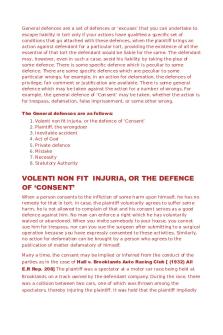Defences III - Lecture 15 PDF

| Title | Defences III - Lecture 15 |
|---|---|
| Author | Muhammad Talha Mushtaq Ghick |
| Course | Criminal law |
| Institution | University of London |
| Pages | 2 |
| File Size | 85.7 KB |
| File Type | |
| Total Downloads | 153 |
| Total Views | 356 |
Summary
Defences III 2013Self Defence: Self-defence is laid down in common law and statute. In common law it provides that it is protection of life and limb of yourself or another or protection of property (private defence). In statute it provides that in S Criminal Law Act 1967 : ‘.. person may use such fo...
Description
Defences III 2013 Self Defence: Self-defence is laid down in common law and statute. In common law it provides that it is protection of life and limb of yourself or another or protection of property (private defence). In statute it provides that in S.3 Criminal Law Act 1967: ‘…a person may use such force as is reasonable in the circumstances in the prevention of crime, or in effecting or assisting in the lawful arrest of offenders or suspected offenders or of persons unlawfully at large…’ The law governing the defences of self-defence was recently consolidated in S.76 Criminal Justice and Immigration Act 2008, and the prosecution must disprove self-defence. The defences, both, operate the same rules as established in McInnes [1971]. The defences of self-defence are successful only if the force used by the D was ‘reasonable’. In most cases, what is reasonable is a simple matter of fact. Bird [1985] – There is no legal requirement that D must retreat from an attack but failure to do so is something the jury can consider when deciding if D used reasonable force. AG’s Ref (No 2 of 1983) [1984] – D may act pre-emtively but the overriding factor is always whether the action is reasonable. Sections 76 (3) and (4) start to explain what the legal requirements of reasonable force include:
Was the level of force necessary – subjective test – R v Oatridge [1992] Reasonableness is to be decided by reference to the circumstances as D believed them to be – objective test – R v Owino [1996] So if D makes a mistake and believes he is under attack when he is not, he is judged on the facts as he saw them. This is a subjective test as is illustrated by Williams (Gladstone) [1987] There are policy reasons for restricting the availability of defences where D was drunk: O’Grady [1987] and R v O’Connor [1991] (not enable D to rely on any mistaken belief where intoxication was voluntary). The amount of force used is always assessed objectively – Drane [2008] – but the law is less generous here than where D is mistaken about the need to use any force at all. See: Martin (Anthony) [2003]. ‘The heat of the moment’ and not revenge or premeditated as illustrated in Palmer v R [1971].
All or nothing defence, no substitution of lesser offence – R v Clegg [1995] Infancy:
1
Criminal Law – Year 2!
Defences III 2013 Under 10 years old – a child under the age of 10 years old is legally incapable of forming the MR for any criminal offence. This means the child is ‘ doli incapax’. 10 years old or above – S.34 Crime and Disorder Act 1998 has abolished the rebuttable presumption of ‘doli incapax’ for 10-14 year olds. This was confirmed by the Court of Appeal in R v T [2008].
2
Criminal Law – Year 2!...
Similar Free PDFs

Defences III - Lecture 15
- 2 Pages

Defences II - Lecture 14
- 4 Pages

Defences - Lecture 13
- 3 Pages

Defences IIII - Lecture 16
- 4 Pages

Defences
- 3 Pages

Defences
- 3 Pages

Defences Notes
- 13 Pages

Defences - Torts
- 13 Pages

Lecture 15
- 7 Pages

Lecture 15
- 2 Pages

Lecture 15 -
- 9 Pages

Negligence – Defences
- 4 Pages

General Defences
- 28 Pages
Popular Institutions
- Tinajero National High School - Annex
- Politeknik Caltex Riau
- Yokohama City University
- SGT University
- University of Al-Qadisiyah
- Divine Word College of Vigan
- Techniek College Rotterdam
- Universidade de Santiago
- Universiti Teknologi MARA Cawangan Johor Kampus Pasir Gudang
- Poltekkes Kemenkes Yogyakarta
- Baguio City National High School
- Colegio san marcos
- preparatoria uno
- Centro de Bachillerato Tecnológico Industrial y de Servicios No. 107
- Dalian Maritime University
- Quang Trung Secondary School
- Colegio Tecnológico en Informática
- Corporación Regional de Educación Superior
- Grupo CEDVA
- Dar Al Uloom University
- Centro de Estudios Preuniversitarios de la Universidad Nacional de Ingeniería
- 上智大学
- Aakash International School, Nuna Majara
- San Felipe Neri Catholic School
- Kang Chiao International School - New Taipei City
- Misamis Occidental National High School
- Institución Educativa Escuela Normal Juan Ladrilleros
- Kolehiyo ng Pantukan
- Batanes State College
- Instituto Continental
- Sekolah Menengah Kejuruan Kesehatan Kaltara (Tarakan)
- Colegio de La Inmaculada Concepcion - Cebu


